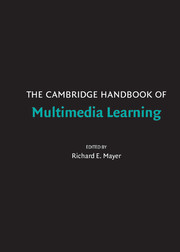
-
Select format
-
- Publisher:
- Cambridge University Press
- Publication date:
- June 2012
- August 2005
- ISBN:
- 9780511816819
- Dimensions:
- Weight & Pages:
- Dimensions:
- Weight & Pages:
- Collection:
- Cambridge Handbooks of Psychology
You may already have access via personal or institutional login- Collection:
- Cambridge Handbooks of Psychology
Book description
In the last decade, the field of multimedia learning emerged as a coherent discipline with an accumulated research base that had never been synthesized and organized in a handbook. The Cambridge Handbook of Multimedia Learning, first published in 2005, constituted the world's first handbook devoted to comprehensive coverage of research and theory in the field of multimedia learning. Multimedia learning is defined as learning from words (e.g., spoken or printed text) and pictures (e.g. illustrations, photos, maps, graphs, animation, or video). The focus of this handbook is on how people learn from words and pictures in computer-based environments. Multimedia environments include online instructional presentations, interactive lessons, e-courses, simulation games, virtual reality, and computer-supported in-class presentations. The Cambridge Handbook of Multimedia Learning seeks to establish what works (that is, to ground research in cognitive theory), and to consider when and where it works (that is, to explore the implications of research for practice).
Reviews
"…a valuable, well organized, educationally relevant source. It will be valuable for education departments, psychology courses, communication departments, instructional technology personnel, or anyone who would like to use multimedia thoughtfully. Highly recommended."
--Choice
Contents
Metrics
Altmetric attention score
Full text views
Full text views help Loading metrics...
Loading metrics...
* Views captured on Cambridge Core between #date#. This data will be updated every 24 hours.
Usage data cannot currently be displayed.
Accessibility standard: Unknown
Why this information is here
This section outlines the accessibility features of this content - including support for screen readers, full keyboard navigation and high-contrast display options. This may not be relevant for you.
Accessibility Information
Accessibility compliance for the PDF of this book is currently unknown and may be updated in the future.


